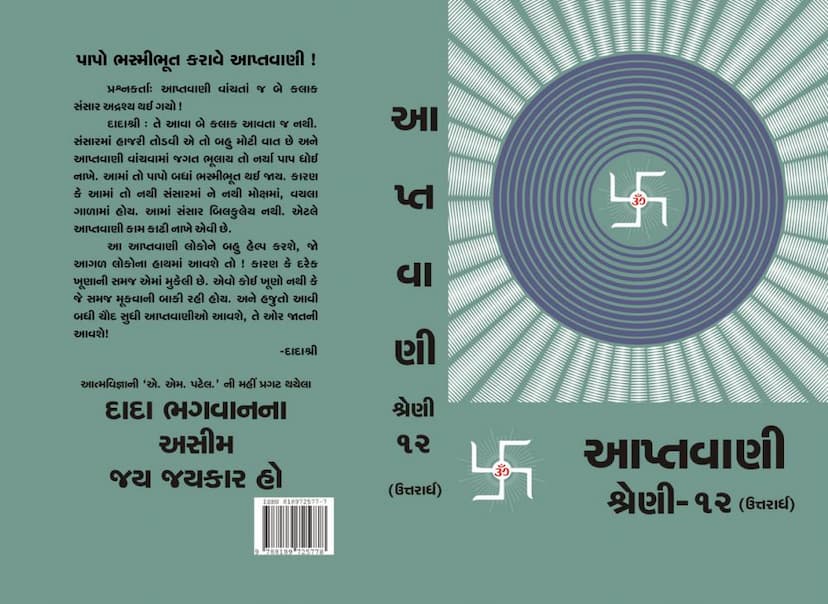Aptavani 12 U
Added to library: September 1, 2025

Summary
Here's a comprehensive summary of the Jain text "Aptavani 12 U" by Dada Bhagwan, based on the provided content:
Book Title: Aptavani 12 U (Part 2) Author: Dada Bhagwan Publisher: Dada Bhagwan Foundation Language: Gujarati (with English summary provided here)
Overview: "Aptavani 12 U" is part of a series of spiritual discourses by Param Pujya Dadashri, referred to as Dada Bhagwan, a fully enlightened being. This volume delves into profound spiritual principles and practical guidance for self-realization and liberation (Moksha) through the Akram Vignan (Easier Path of Self-Knowledge) path. The book compiles Dada Bhagwan's answers to questions posed by spiritual seekers (Mahatmas) about various aspects of spiritual progress, inner purity, and righteous conduct in worldly interactions.
Key Themes and Concepts:
- The Importance of Following the Gnani's Commands (Aagnya): A central theme is the absolute necessity of adhering to the five commands given by the Gnani (Dada Bhagwan). These commands are presented not as rules but as the very science of liberation, acting as a protective shield for the Self-Knowledge received. Following them, even partially, is guaranteed to lead to Moksha, with the Gnani taking responsibility. The commands are described as a "shortcut" to liberation, bypassing traditional arduous spiritual practices.
- Distinction Between Real and Relative (Real-Relative): The text emphasizes the understanding and constant remembrance of the difference between the real Self (Pure Soul) and the relative self (the ego, body, mind, speech, and intellect). The real Self is eternal and unchanging, while everything else is relative, temporary, and ultimately 'not mine' ('Noy Maru'). The Gnani's discourse aims to instill this constant awareness.
- Samabhav (Equanimity) in Dealing with "Files" (Situations and People): The concept of "files" is used metaphorically to represent all worldly interactions, people, and situations. The core teaching is to deal with all these "files" with "Samabhav" (equanimity), meaning without attachment or aversion. This involves seeing the Pure Soul in everyone and handling every situation without creating new karma. The goal is to have a balanced approach, neither getting overly attached to pleasant experiences nor averse to unpleasant ones.
- The Nature of Actions: Charge and Discharge: The text explains that after Self-Knowledge, new karma (charge) does not bind, but past karma (discharge) continues to manifest. The enlightened individual (Mahatma) observes these discharges without getting involved or creating new charges, thus facilitating liberation. Even if the ego (Chandubhai) makes mistakes, the Self (Pure Soul) remains unaffected.
- The Role of 'Noy Maru' (Not Mine): The constant remembrance and practical application of "Noy Maru" (This is not mine) is presented as a key tool to detach from worldly possessions and experiences, including the body and ego. This declaration helps to separate the Self from the non-Self.
- Karma: Understanding the Cause and Effect: The text clarifies that new karmic causes (karyas) are not created after Self-Knowledge. Whatever is experienced is merely the discharge of past karma. The focus shifts from controlling actions to maintaining awareness of the Pure Self, the pure observer.
- The Nature of True Contentment and Inner Bliss: True happiness (Atma Anand) is not derived from external pleasures (Pudgal Sukh) but is inherent in the Self. External pleasures are temporary and lead to further bondage. The ultimate goal is the inherent bliss of the Self, which is discovered by detaching from worldly desires and maintaining awareness of the Pure Soul.
- The Importance of Right Understanding and Focus on the Goal: The ultimate goal is Moksha. While worldly duties continue, the focus must remain on the Self. Following the Gnani's guidance, particularly the five commands, is the path to this goal. The emphasis is on understanding the ultimate purpose and not getting lost in worldly distractions or the finer points of spiritual theories.
- The Power of Satsang (Association with the Enlightened): Satsang is highlighted as crucial for maintaining spiritual progress and awareness. It provides constant guidance and protection from the negative influences of the world (kusang). The presence of the Gnani, even in subtle form, is essential for steady progress.
- The Nature of True Knowledge and Faith: True knowledge leads to unwavering faith in the Self. The understanding of 'Noy Maru' helps to dissolve ego and attachment. The text distinguishes between mere intellectual understanding and the direct experience of the Self, emphasizing the latter as the ultimate aim.
- The Significance of Inner Discipline (Sanyam) and Inner Penance (Tap): True penance (Tap) is presented as an inner process of observing one's thoughts and actions without judgment, rather than external austerities. Following the Gnani's commands and maintaining inner equanimity, especially during challenging situations, is considered the highest form of penance.
Key Teaching: The overarching message of Aptavani 12 U is that through the Akram Vignan path, one can attain Self-Realization and progress towards Moksha by living in accordance with the Gnani's divine commands and maintaining constant awareness of the Pure Soul. The emphasis is on inner transformation through unwavering faith and practical application of spiritual principles, transcending external rituals and worldly entanglements. The book stresses the scientific and experiential nature of Dada Bhagwan's teachings, offering a clear and direct path to liberation.
Availability: The book is published by Dada Bhagwan Foundation and is available through their distribution channels.
This summary attempts to capture the essence of the provided text, highlighting the core teachings and practical guidance offered by Param Pujya Dadashri.